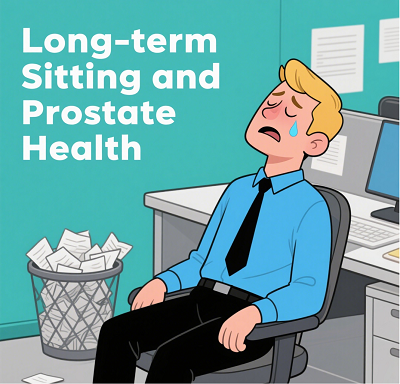How Prolonged Sitting Affects Prostate Health—And What You Can Do About It
The relationship between prolonged sitting and prostate diseases has garnered widespread attention in recent years, particularly in modern life. With the development of office automation and transportation, the average daily sitting time for adults has exceeded 8 hours, making prolonged sitting a norm for many.

While prolonged sitting itself does not directly cause prostate diseases, long-term unhealthy lifestyle habits may have certain impacts on prostate health. According to clinical observations, the incidence of prostatitis among occupational groups such as office workers and long-distance drivers is 2-3 times higher than that of the general population. Prolonged sitting has become an invisible threat to male prostate health, and this often-overlooked health issue deserves serious attention.
What Are the Specific Effects of Prolonged Sitting?
Impaired Blood Circulation
Prolonged sitting increases pressure on the perineum, leading to restricted blood flow and causing the prostate to remain in a state of congestion for extended periods. Under normal circumstances, proper blood circulation in the prostate supports its metabolism and nutrient supply. However, congestion can cause blood stasis, impairing normal prostate function and preventing the elimination of metabolic waste. These accumulated waste products then become a "breeding ground" for bacteria, ultimately leading to prostatitis.
Elevated Local Temperature
During prolonged sitting, the perineum remains in close contact with the seat, making heat dissipation difficult and raising the local temperature of the prostate. Even a slight rise in temperature can disrupt the delicate balance of the prostate’s internal environment, directly affecting the secretion and excretion of prostatic fluid. Prostatic fluid has antibacterial and anti-inflammatory properties, and abnormalities in its secretion and excretion can increase the risk of prostatitis.
Weakened Immune Function
Sitting for long periods without movement significantly reduces physical activity, gradually weakening the body's overall resistance. The immune system is a crucial defense against diseases, and when immune function declines, the body becomes more susceptible to pathogen invasion. For the prostate, this means a higher likelihood of infection, which can trigger inflammation.
Pelvic Floor Muscle Tension
Maintaining a seated position induces sustained tension in the pelvic floor musculature, which concurrently exerts compressive forces on the prostate. This persistent muscular tension may compromise both vascular perfusion and neural signaling to the prostate, resulting in functional dysregulation. Such chronic mechanical compression and physiological dysfunction can induce structural damage to prostatic tissue, consequently elevating the probability of prostatitis occurrence.
Prostatic Duct Obstruction
Continuous sedentary behavior may precipitate both circulatory impairment and pelvic floor muscle tension, potentially progressing to obstruction of prostatic ducts. These ducts serve as conduits for prostatic fluid drainage; their obstruction leads to progressive accumulation of fluid buildup in the prostate. Over time, this stagnant fluid environment becomes particularly conducive to infectious processes, ultimately triggering inflammatory responses.
Fortunately, there are several ways to protect your prostate even if you can't avoid sitting for long hours.
How to Prevent or Mitigate These Effects?
To prevent or mitigate the potential impacts of prolonged sitting on prostate health, the following measures can be taken:
First, medical intervention can be employed, clinical treatment of prostate diseases often adopts a combined strategy of traditional Chinese and Western medicine. For Chinese medicine, formulations such as Diuretic and Anti-inflammatory Pill with heat-clearing, detoxifying, anti-inflammatory and antibacterial effects can be selected; for Western medicine, α-receptor blockers can effectively alleviate urinary abnormalities. This targeted medication approach can control prostate inflammation at its root while preventing complications.
Second, take regular breaks to stand up and move around. Perform brief walks or light stretching every 30–60 minutes to promote systemic blood circulation. Additionally, patients with prostatitis who unavoidably need to sit for prolonged periods due to work or other reasons can use ergonomic chairs, which help reduce pressure on the perineal area, while simultaneously avoiding crossing their legs.
Third, strengthen your daily exercise routine by choosing suitable physical activities, such as swimming or jogging. These help enhance the overall constitution and boost immunity, significantly reducing the likelihood of developing prostatitis or worsening existing symptoms.
Fourth, make dietary adjustments by increasing water intake and consuming more foods rich in vitamins and minerals (such as tomatoes, which contain lycopene, and pumpkin seeds, rich in zinc) while reducing your intake of spicy and irritating foods (such as alcohol and caffeine).
Fifth, maintain a positive mindset or mental well-being, ensure adequate sleep, and avoid excessive tension or anxiety, as this can place an additional burden on the body. A healthy mentality is the key to maintaining physical health.
Sixth, high-risk groups should undergo professional prostate risk assessment annually to prevent unnoticed prostate damage. Occupations such as programmers and drivers are considered high-risk populations.
Apart from the aforementioned non-acute symptoms, if patients experience persistent pelvic pain lasting over two weeks, severe nocturia frequency, noticeably narrowed urine stream, or unrelieved perineal heaviness, these indicate more serious conditions that require immediate medical consultation. Seeking professional medical help is crucial to avoid misdiagnosis or the detrimental consequences of delayed treatment.
While sitting for extended periods has become a daily reality for many, its impact on men’s health—especially prostate function—should not be overlooked. Through consistent lifestyle improvements and timely medical intervention, you can significantly reduce the risks. If you’re already experiencing symptoms like pelvic pain, frequent urination at night, or discomfort in the perineal area, don’t ignore them. Early consultation with a specialist can make all the difference for your long-term health.



